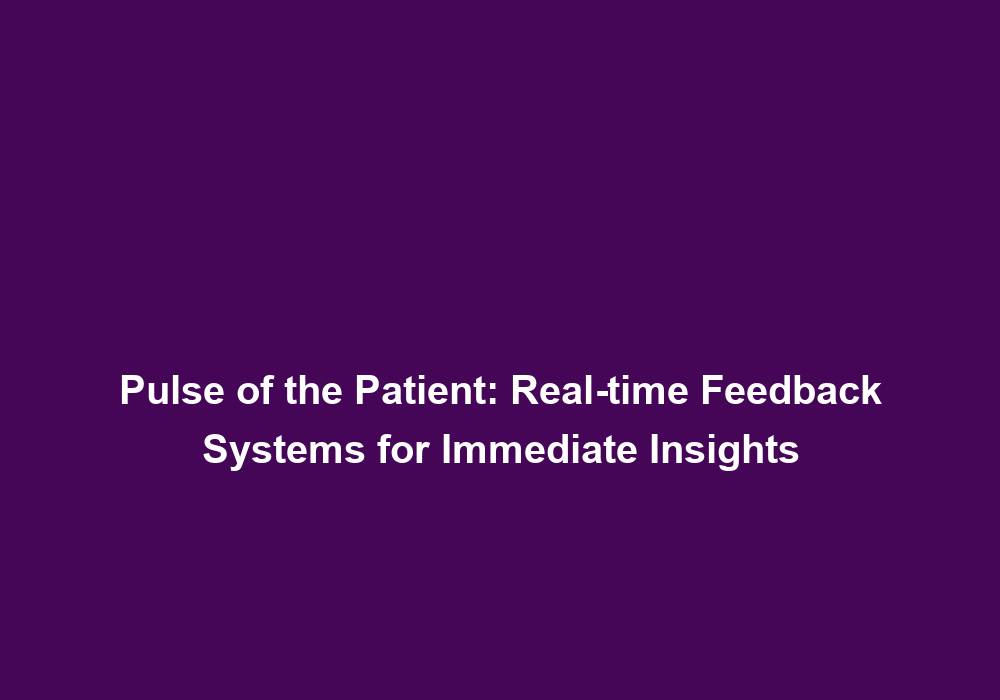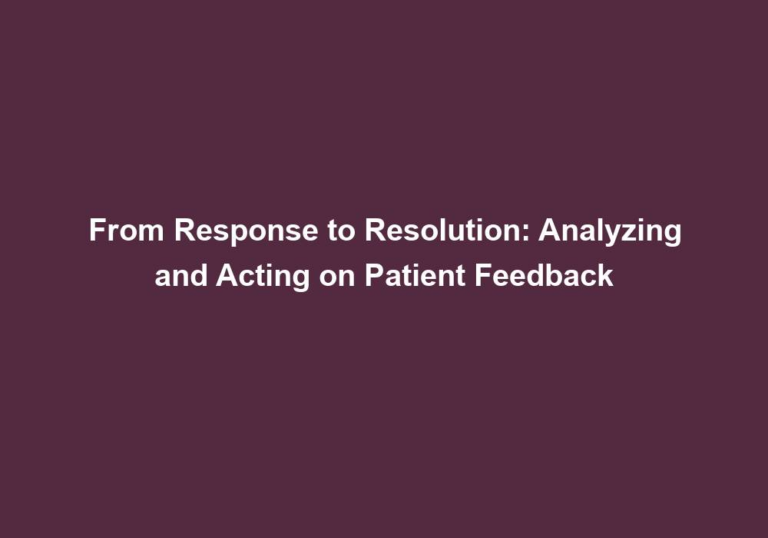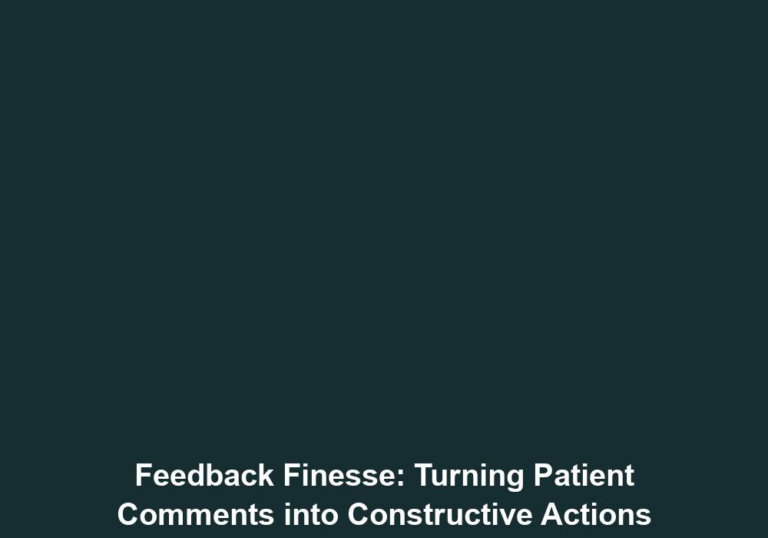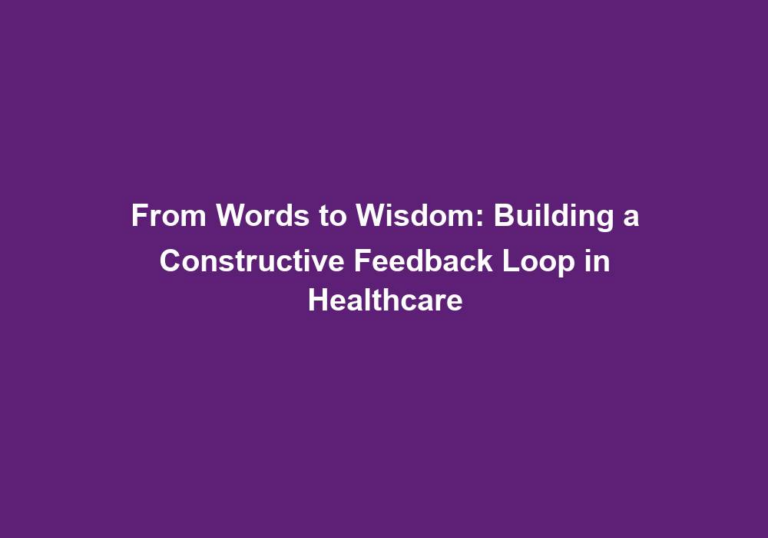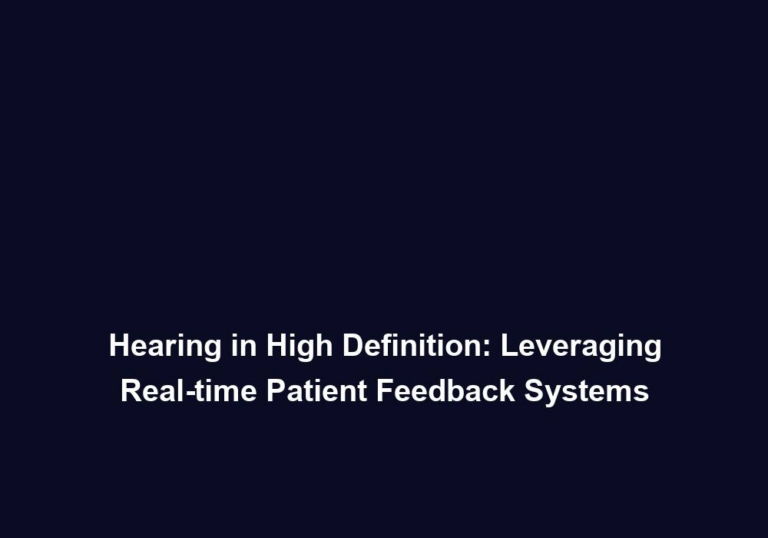Pulse of the Patient: Real-time Feedback Systems for Immediate Insights
In today’s fast-paced healthcare industry, it is essential for healthcare providers to gather real-time feedback from their patients. This feedback not only allows providers to gauge the quality of their services but also provides valuable insights for immediate improvements. To achieve this, healthcare organizations are increasingly adopting real-time feedback systems that enable them to monitor the pulse of the patient and make informed decisions promptly.
The Importance of Real-time Feedback Systems
Real-time feedback systems are crucial for healthcare organizations for several reasons:
- Enhancing Patient Satisfaction:
- Real-time feedback systems empower patients to voice their opinions and concerns immediately, ensuring that their experiences are heard and addressed promptly. This level of engagement creates a sense of trust and partnership between patients and providers.
- By actively attending to patient feedback, healthcare providers can improve the overall patient experience, leading to increased patient satisfaction and loyalty. Addressing concerns in real-time demonstrates a commitment to quality care and patient-centeredness.
- Continuous Quality Improvement:
- Real-time feedback systems allow healthcare organizations to identify areas for improvement promptly. By collecting feedback as it happens, providers can uncover potential issues and take immediate action to address them.
- By addressing issues in real-time, providers can make necessary adjustments to their processes, leading to enhanced quality of care. Continuous quality improvement is essential for healthcare organizations to stay competitive and deliver the best possible outcomes for their patients.
- Timely Issue Resolution:
- Real-time feedback systems enable healthcare providers to identify and resolve issues as they arise. This proactive approach minimizes the impact on patients and prevents potential escalation, resulting in improved patient safety.
- Prompt issue resolution also helps maintain a positive reputation for healthcare organizations, as patients feel heard and valued. It demonstrates a commitment to patient-centered care and a dedication to providing the best possible experience.
Key Components of Real-time Feedback Systems
To effectively implement real-time feedback systems, healthcare organizations should consider the following key components:
- Multi-channel Feedback Collection:
- Real-time feedback systems should be designed to collect feedback from multiple channels, such as mobile apps, online surveys, text messages, or interactive kiosks. This allows patients to provide feedback through their preferred method, increasing response rates and capturing a more comprehensive range of perspectives.
- By providing patients with various options to express their opinions, healthcare organizations can gather comprehensive and unbiased feedback. This diversity of feedback helps identify trends and patterns that may not be apparent through a single channel.
- Automated Data Collection and Analysis:
- Real-time feedback systems should automate the collection and analysis of data to minimize manual effort and errors. This automation streamlines the feedback process and ensures data accuracy and consistency.
- Advanced analytics tools can help identify patterns and trends in feedback, enabling organizations to gain actionable insights more efficiently. These insights can inform decision-making and drive targeted improvements, ultimately enhancing the quality of care.
- Instant Alerts and Notifications:
- Real-time feedback systems should have the capability to send instant alerts and notifications to relevant staff members. This ensures that critical feedback is immediately brought to the attention of the appropriate individuals, allowing for timely intervention and problem-solving.
- Prompt alerts and notifications enable healthcare providers to address urgent issues promptly, preventing potential harm to patients and demonstrating a commitment to patient safety.
- Customizable Reporting and Dashboards:
- Real-time feedback systems should provide customizable reporting and dashboards to visualize feedback data effectively. Customization options allow healthcare providers to focus on the metrics that matter most to their organization, facilitating data-driven decision-making.
- By tailoring reporting and dashboards to specific needs, healthcare organizations can monitor key performance indicators, track progress, and identify areas for improvement. This level of customization promotes transparency and accountability within the organization.
Benefits of Real-time Feedback Systems
Implementing real-time feedback systems brings several benefits for both patients and healthcare organizations:
- Improved Patient Engagement:
- Real-time feedback systems empower patients by engaging them in their own care journey. When patients feel their opinions matter, they become more involved in their healthcare decisions and are more likely to actively participate in their treatment plan.
- By actively involving patients in their care, healthcare organizations can improve patient outcomes, enhance patient satisfaction, and foster a sense of ownership over their health.
- Enhanced Staff Performance:
- Real-time feedback systems provide healthcare providers with insights into staff performance. By identifying areas where staff members excel or require further training, organizations can implement targeted interventions to improve overall performance and patient satisfaction.
- This feedback loop creates a culture of continuous learning and improvement, leading to higher employee engagement and satisfaction. Staff members feel valued when their efforts are acknowledged and rewarded, resulting in a more positive work environment.
- Proactive Issue Resolution:
- Real-time feedback systems allow healthcare organizations to proactively identify issues and resolve them promptly. By capturing feedback in real-time, providers can address concerns before they escalate into larger problems.
- By nipping potential problems in the bud, providers can prevent negative experiences for patients and maintain a positive reputation. This proactive approach builds trust and confidence in the healthcare organization’s ability to deliver high-quality care consistently.
- Data-driven Decision-making:
- Real-time feedback systems provide healthcare organizations with a wealth of data that can be used for informed decision-making. By analyzing feedback trends and patterns, providers can identify areas for improvement, allocate resources effectively, and develop patient-centric strategies.
- Data-driven decision-making enables healthcare organizations to make evidence-based choices that have a direct impact on patient outcomes and organizational performance. It promotes a culture of continuous improvement and innovation.
Implementing Real-time Feedback Systems: Best Practices
To ensure successful implementation of real-time feedback systems, healthcare organizations should follow these best practices:
- Clear Communication:
- Healthcare organizations must communicate the purpose and benefits of real-time feedback systems to patients. Clear communication helps patients understand the value of their feedback and how it contributes to improved care.
- Educating patients about the importance of their feedback encourages active participation and fosters a sense of partnership between patients and providers. Transparent communication builds trust and strengthens the patient-provider relationship.
- Training and Support:
- Staff members should be adequately trained to utilize real-time feedback systems effectively. Training ensures that staff members understand the system’s functionalities and can navigate it with ease.
- Providing ongoing support and guidance ensures that staff members can utilize the collected data to drive meaningful improvements. Regular training sessions and access to resources help staff members stay up to date with the system’s capabilities and make the most of the feedback data.
- Encouraging Anonymity:
- Real-time feedback systems should allow patients to provide feedback anonymously, fostering open and honest responses. Anonymity encourages patients to provide constructive criticism without fear of negative consequences, resulting in more accurate feedback.
- When patients feel safe to express their opinions freely, healthcare organizations can gather more honest and valuable feedback. Anonymity also eliminates potential biases that may arise when patients feel obligated to provide positive feedback.
- Regular Review and Action:
- Healthcare organizations should establish a process to regularly review and analyze the feedback collected. Regular review helps identify trends, patterns, and areas for improvement.
- By prioritizing actionable items and implementing necessary changes promptly, organizations demonstrate their commitment to continuous improvement. Regular review and action show patients that their feedback is taken seriously and leads to tangible improvements in the quality of care.
Conclusion
Real-time feedback systems play a pivotal role in modern healthcare by capturing the pulse of the patient and providing immediate insights for quality improvement. By embracing these systems, healthcare organizations can enhance patient satisfaction, drive continuous quality improvement, and make data-driven decisions. With the right implementation strategies and a commitment to ongoing improvement, real-time feedback systems can revolutionize the way healthcare providers deliver care, ultimately benefiting both patients and providers alike.

